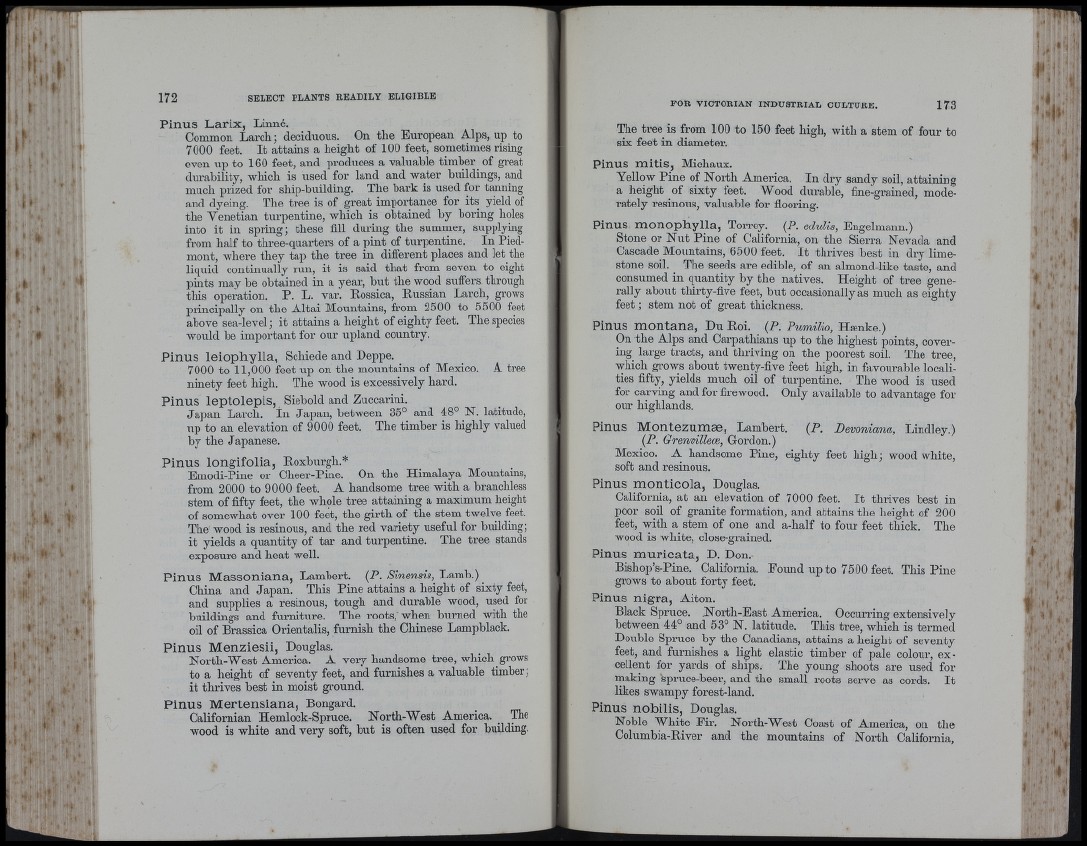
, ' I i
172 SELECT PLANTS READILY ELIGIBLE
Pinus Larix, Linné.
Common Larch; deciduous. Cn the European Alps, np to
7000 feet. I t attains a height of 100 feet, sometimes rising
even up to 160 feet, and produces a valuable timber of great
durability, which is used for land and water buildings, and
mucli prized for ship-building. Tbe bark is used for tanning
and dyeing. The tree is of great importance for its yield of
tbe Venetian turpentine, which is obtained by boring holes
into it in spring; these fill during the summer, supplying
from half to three-quarters of a pint of turpentine. In Piedmont,
where they tap the tree in difierent places and let the
liquid continually run, it is said that from seven to eight
pints may be obtained in a year, but the wood suffers through
tbis operation. P. L. var. Kossica, Russian Larcli, grows
principally on tbe Altai Mountains, from 2500 to 5500 feet
above sea-level ; it attains a height of eighty feet. The species
would be important for our upland country.
Pinus leiophylla, Schiede and Deppe.
7000 to 11,000 feet up on the mountains of Mexico. A tree
ninety feet high. The wood is excessively hard.
Pinus leptolepis, Siebold and Zuccarini.
Japan Larch. In Japan, between 35° and 48° N. latitude,
up to an elevation of 9000 feet. The timber is highly valued
by the Japanese.
Pinus longifolia, Roxburgh.*
Emodi-Pine or Cheer-Pine. Cn the Himalaya Mountains,
from 2000 to 9000 feet. A handsome tree with a branchless
stem of fifty feet, the whole tree attaining a maximum height
of somewhat over 1 0 0 feet, the girth of the stem twelve feet.
The wood is resinous, and the red variety useful for building;
it yields a quantity of ta r and turpentine. Tbe tree stands
exposure and heat well.
Pinus Massoniana, Lambert. (P. Sinensis, Lamb.)
China and Japan. This Pine attains a height of sixty feet,
and supplies a resinous, tough and durable wood, u p d for
buildings and furniture. The roots,'when burned with the
oil of Brassica Crientalis, furnish the Chinese Lampblack,
Pinus Menziesii, Douglas.
North-West America. A very handsome tree, w h i c h grows
to a height of seventy feet, and furnishes a valuable timber ;
it thrives best in moist ground.
Pinus Mertensiana, Bongard.
Californian Hemlock-Spruce. North-West America. The
wood is white and very soft, but is often used for building.
FOR VICTORIAN INDUSTRIAL CULTURE. 173
The tree is from 100 to 150 feet high, with a stem of four to
six feet in diameter.
Pinus mitis, Michaux.
Yellow Pine of North America. In dry sandy soil, attaining
a height of sixty feet. Wood durable, fine-grained, moderately
resinous, valuable for flooring.
Pinus monophylla, Torrey. (P. edulis, Engelmann.)
Stone or Nut Pine of California, on the Sierra Nevada and
Cascade Mountains, 6500 feet. I t thrives best in dry limestone
soil. The seeds are edible, of an almond-like taste, and
consumed in quantity by the natives. Height of tree generally
about thirty-five feet, but occasionally as much as eighty
feet; stem not of great thickness.
Pinus montana, Du Roi. (P. Pumilio, H^nke.)
Cn the Alps and Carpathians np to the highest points, covering
large tracts, and thriving on the poorest soil. The tree,
which grows about twenty-five feet high, in favourable localities
fifty, yields much oil of turpentine. The wood is used
for carving and for firewood. Cnly available to advantage for
our highlands.
Pinus Montezumae, Lambert. (P. Devoniana, Lindley.)
(P. Grenvillece, Gordon.)
Mexico. A handsome Pine, eighty feet high; wood white,
soft and resinous.
Pinus montícola, Douglas.
California, at an elevation of 7000 feet. I t thrives best in
poor soil of granite formation, and attains the height of 2 0 0
feet, with a stem of one and a-half to four feet thick. The
wood is white, close-grained.
Pinus muricata, D. Don.
Bishop’s-Pine. California. Found up to 7500 feet. This Pine
grows to about forty feet.
Pinus nigra, Aiton.
Black Spruce. .North-East America. Cccnrring extensively
between 44° and 53° N. latitude. This tree, which is termed
Double Spruce by the Canadians, attains a height of seventy
feet, and furnishes a light elastic timber of pale colour, excellent
for yards of ships. The young shoots are used for
making spruce-beer, and the small roots serve as cords. I t
likes swampy forest-land.
Pinus nobilis, Douglas.
Noble White Fir. North-West Coast of America, on the
Columbia-River and the mountains of North California,
• I
I ,